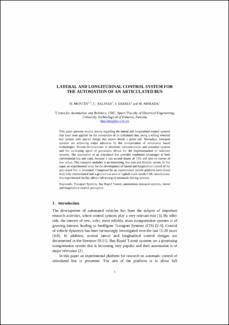| dc.contributor.author | Montes Franceschi, Héctor | |
| dc.contributor.author | Salinas, Carlota | |
| dc.contributor.author | Sarria, Javier | |
| dc.contributor.author | Armada, Manuel | |
| dc.date.accessioned | 2017-08-01T16:51:58Z | |
| dc.date.accessioned | 2017-08-01T16:51:58Z | |
| dc.date.available | 2017-08-01T16:51:58Z | |
| dc.date.available | 2017-08-01T16:51:58Z | |
| dc.date.issued | 2010-07-02 | |
| dc.date.issued | 2010-07-02 | |
| dc.identifier.uri | http://ridda2.utp.ac.pa/handle/123456789/2405 | |
| dc.identifier.uri | http://ridda2.utp.ac.pa/handle/123456789/2405 | |
| dc.description | This paper presents several results regarding the lateral and longitudinal control systems that have been applied for the automation of an articulated bus, using a rolling wheeled box system with special design that moves inside a guide rail. Nowadays, transport systems are achieving major advances by the incorporation of automation based technologies. Recent developments of electronic instrumentation and actuation systems and the increasing speed of processors allows for the implementation of real-time systems. The automation of an articulated bus provides combined advantages of both conventional bus and train, because it can ascend slopes of 15% and turn on curves of low radius. This transport modality is an interesting, low cost and friendly option. In this paper an experimental setup for the development of lateral and longitudinal control of the articulated bus is presented. Comprised by an experimental mobile platform (articulated bus) fully instrumented and a ground test area of asphalt roads inside CSIC installations, this experimental facility allows full testing of automatic driving systems. | en_US |
| dc.description.abstract | This paper presents several results regarding the lateral and longitudinal control systems that have been applied for the automation of an articulated bus, using a rolling wheeled box system with special design that moves inside a guide rail. Nowadays, transport systems are achieving major advances by the incorporation of automation based technologies. Recent developments of electronic instrumentation and actuation systems and the increasing speed of processors allows for the implementation of real-time systems. The automation of an articulated bus provides combined advantages of both conventional bus and train, because it can ascend slopes of 15% and turn on curves of low radius. This transport modality is an interesting, low cost and friendly option. In this paper an experimental setup for the development of lateral and longitudinal control of the articulated bus is presented. Comprised by an experimental mobile platform (articulated bus) fully instrumented and a ground test area of asphalt roads inside CSIC installations, this experimental facility allows full testing of automatic driving systems. | en_US |
| dc.language | eng | |
| dc.language.iso | eng | en_US |
| dc.rights | https://creativecommons.org/licenses/by-nc-sa/4.0/ | |
| dc.rights | info:eu-repo/semantics/openAccess | |
| dc.subject | Transport Systems | en_US |
| dc.subject | Bus Rapid Transit | en_US |
| dc.subject | autonomous transport systems | en_US |
| dc.subject | lateral and longitudinal control | en_US |
| dc.subject | perception | en_US |
| dc.subject | Transport Systems | |
| dc.subject | Bus Rapid Transit | |
| dc.subject | autonomous transport systems | |
| dc.subject | lateral and longitudinal control | |
| dc.subject | perception | |
| dc.title | Lateral and Longitudinal Control System for the Automation of an Articulated Bus | en_US |
| dc.type | info:eu-repo/semantics/article | |
| dc.type | info:eu-repo/semantics/publishedVersion | |
